Wells-next-the-Sea Lifeboat Station
Wells-next-the-Sea Lifeboat Station is an RNLI operated lifeboat station located in the town of Wells-next-the-Sea in the English county of Norfolk.[1] The station operates both inshore and offshore lifeboats. The inshore boat is called Jane Ann III (D-661)[2] and is a D-class (IB1) lifeboat, whilst the offshore boat is called Doris M, Mann of Ampthill (ON 1161),[3] and is a Mersey class lifeboat. The station boathouse is located at the beach on the western side of Wells Harbour mouth.[4]
| Wells-next-the-Sea lifeboat station | |
|---|---|
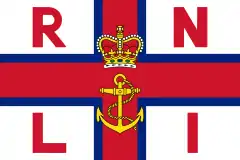 | |
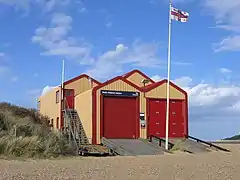 Wells lifeboat station | |
 | |
| General information | |
| Type | RNLI Lifeboat Station |
| Architectural style | Steelframe Boathouse with brick and block construction |
| Location | Wells Lifeboat Station, Beach Road, Wells-next-the-Sea, Norfolk, NR23 1DR |
| Country | England |
| Coordinates | 52°58′22.5″N 0°51′6.12″E |
| Opened | 1830 Taken over by RNLI in 1869 |
| Owner | Royal National Lifeboat Institution (RNLI) |
History
The Longshoremen and Norfolk Shipwreck Association
The earliest attempts at rescue at sea in the Wells area were performed by the Beachmen[5] or Longshoremen who formed their own Beachmen’s company at Wells,[6] and used a fast sailing yawl to rescue and salvage distressed vessels along this part of the coast. However this was done to the benefit of both parties.[5] On reaching a distressed vessel, the beachmen could claim right of salvage and with this in mind there would be a negotiation where terms of employment were settled with the beachmen often driving home a hard bargain.[5] The beachmen’s work was arduous and fraught with danger, and on many occasions they earned nothing at all.
The first organised rescue service at Wells was run by the Norfolk Shipwreck Association and began in 1830[4] when an existing lifeboat that had been at Cromer was sent to Wells. The boat had no name but was of the Greathead or North Country non self-righter type. It was a pulling lifeboat and was powered with ten oars.
1869 Lifeboat House
By the 1860s the lifeboat operation run by the Norfolk Shipwreck Association had fallen into a rapid decline with no lifeboat stationed at Wells, whilst at this same time there was a marked increase in the number of maritime incidents of the shores of North Norfolk. In 1868 the newly formed RNLI was approached by the local townsfolk to see if they would re-organise the lifeboat service in the town. The RNLI sent an inspector, who reported back to the Institute's Committee of Management recommending the setting up of an organised lifeboat service in the town. The RNLI agreed, and a new self-righting lifeboat of the latest design was ordered for the town. To accommodate the new lifeboat the construction of a substantial new boathouse[7] was begun, on the quay close to the town. The building was opened in 1869, along with the new lifeboat. The lifeboat was a 33-foot self-righting type and was called RNLB Eliza Adams.[8] This lifeboat house was used until 1895 when the service was re-located at the far end of Beach Road. The Grade II listed building[9] still stands and is used jointly as the Harbour Masters Office and a Maritime Museum.
Location problems
In the latter part of the 1800s it was becoming clear to the local lifeboatmen that their station was not in the most useful location and was more than a mile from the open sea. The problem was highlighted in 1893 when the lifeboat RNLB Baltic (ON 198)[8][10] was launched to service on three occasions and failed to effect any rescues. The collier Duke of Cornwall was wrecked east of Wells, fortunately without loss of life. In the same day the barge Lord Beresford was driven ashore at Holkham beach with her crew rescued from the rigging without any help from the lifeboat. The third failure occurred two days later when the schooner Hickman went ashore at Wells Bar. Most of the crew were eventually rescued but two of the crew died of exposure after taking to the rigging. The struggling lifeboat was beached and two of her crew were washed overboard but were rescued. The problem was that at low water the lifeboat could not get out into the open sea and relied on the rise and fall of the tide too much. Even with a favourable tide if the wind was against the lifeboat it effectively was trapped in the Harbour.
Re-location
To remedy the location problem the RNLI acquired some land 1.2 miles (1.9 km) north of the existing station on the western point overlooking the harbour mouth. Work began on the new station in 1894 but due to delays the station was not ready until October 1895. The previous problems had also highlighted the Baltic’s shortfalls and the station was supplied with a more efficient lifeboat. The new lifeboat was of a type which the Wells crew preferred, a Cromer Self-righting type built by Beeching Bros of Great Yarmouth.[11] The new lifeboat arrived on station in July 1895 and was called RNLB Baltic (ON 375)[8][10] and was a pulling lifeboat with 14 oars. Whilst on the station she was launched to service a total of 13 times and is credited with saving 19 lives.[8]
First motor lifeboat
Although the RNLI had been considering the idea of providing Wells with a motor lifeboat since 1911, it was not until July 1936 that the station was provided with one. This was because of the launching situation at Wells and the need for carriage launched motor lifeboat to be designed. The Surf-class lifeboat[12] was designed by James Barnett and was light enough for the beach launch required at Wells. RNLB Royal Silver Jubilee (ON 780) was also the first Surf-class to be propelled by Hotchkiss Cone[12] propulsion system which was a basic water jet system. This system of propulsion was ideal for conditions at Wells, where the water is very shallow at times and combined with her comparative lightness and shallow draught made her ideal for when the tide is fully out, and the lifeboat required to be taken out several miles to be launched.
Introduction of the inshore lifeboat
By the mid 1960s this area of the North Norfolk coast had seen an increase of pleasure craft and beach leisure activities. The RNLI saw a change in the pattern of casualties with an increasing number of services required to rescue bathers washed out to sea, people on lilos, dinghies, and various small water craft. It was realised locally that a faster first response was needed to attend such situations and to relieve the Wells all-weather lifeboat RNLB Cecil Paine (ON 850) from the inshore workload. In 1963 the inshore service was established and a small boathouse was erected adjacent to the west of the main boat hall at Beach Road. The first inshore boat was a D-class (IB1) with the operation number D-11 which served for the first year of the inshore operations. This boat was followed by a succession of D-class boats. The first to have a name was Spirit of Rotary (D-246), and she was on the station from 1976 until 1987. In January 1978 a severe storm destroyed the IRB house and damaged the doors to the main boathall. A new IRB house was built onto the side of the main station.
Station improvements
The beach road station, over the years, has been improved and renovated on several occasions, to keep the facilities at their optimal state of purpose. Much of the station's original 1895[4] structure is the major integral part of the building. The crew facilities were expanded in 1983[4] by building a first floor above the ILB house previously added to the side of the station. A boathouse extension was added on to the back of the station in 1986.[4] This improvement was necessary to house the inshore lifeboat. The new Talus MB-H T99 tractor[13] which was supplied to improve the launch equipment for the lifeboats was then housed in the old inshore lifeboat house, which also had to be enlarged and altered.
Mersey-class lifeboat arrives
In 1990 the station was allocated a new Mersey-class lifeboat. She was called Doris M. Mann of Ampthill[8][14] and she became operational on 3 July of that year. To accommodate this new lifeboat the station once again had to be considerably enlarged and altered. The house had to be almost completely re-built whilst still retaining the historic integrity of the 1895 station. In the mid 1990s work was also carried out to the outside environment of the station. Work was carried out on the timber revetments and groynes to prevent further coastal erosion of the sandy headland on which the boat house is located. This was achieved by re-using the greenheart[8] timbers re-claimed after the demolition of the Eastbourne[8] slipway. Extra new groynes were also installed to retain the beach in front of the station, vital for the continued beach launching of the lifeboats.
Visiting
With the Wells station barely large enough to house the lifeboats and all their necessary equipment, space is at a premium. Unfortunately the station has no separate public area or viewing gallery, but is still open to the public. The situation gives the visitor an up close experience with the station, but with the need for extra care when moving around the open areas. There is a gift shop and information area but this has limited open hours in the summer and when there are specific events and visits are organised.
Claim to fame
In 1979[8] the station became the subject of an iconic photograph. The photograph named The Rescue Team[15] was taken by Campbell MacCallum.[16] The photo was conceived as a poster project just for display in the crew room of the station. The composition of the photograph included the Oakley-class motor lifeboat RNLB Ernest Tom Neathercoat (ON 982),[8] The inshore lifeboat, the lifeboat crews, officials, supporters, fund-raisers and the local coastguards. The RNLI Headquarters in Poole were given a copy of the photograph and were very impressed. The RNLI requested that they might use the poster to distribute to all its stations and to use as a fund raiser.[8] The photograph was renamed Portrait of a Lifeboat Station and was distributed to all RNLI stations, branches, guilds, Armed Forces, Educational authorities, and many other organisations worldwide. The poster was even sighted on the wall of a 24hr Tailor in downtown Hong Kong.[15] In 1986 the same format was used to produce another poster but this time using the Hastings lifeboat. Wells was chosen again in 1993 and in 2000 for the "Millennium Rescue Team" poster.[8]
The Wells lifeboat disaster
On 29 October 1880, gales were lashing the north coast of Norfolk. The 171 ton Ocean Queen, of Sunderland was on passage from Southampton to Seaham when she was caught in the storm and sought shelter at Wells-next-the-Sea. At 1:00pm, the Wells lifeboat RNLB Eliza Adams launched to the aid of another brig, the Sharon Rose, which had run ashore on the beach at nearby Holkham. Seven sailors were rescued from the vessel and the lifeboat returned safely to Wells. However, on arrival back to the quay, the Ocean Queen was seen close to the harbour entrance, flying a distress flag.
Capsized
After changing 8 of her 13 crew, the Eliza Adams was again towed to sea. By this stage the Ocean Queen had been driven ashore on the nearby sands. The lifeboat reached the brig, but was unable to help and so set sail to return to port. In so doing, a heavy wave broke over the lifeboat and it capsized. The crew of the Ocean Queen remained aboard their vessel, and were able to walk ashore once the storm had abated and the tide receded.
Death toll
Eleven of the 13 crew drowned, leaving 10 widows and 27 children without a father. One crew member, William Bell, managed to stay with the boat until it righted itself. Another, Thomas Kew, was washed ashore alive. A memorial to the members of the Wells lifeboat crew who lost their lives stands adjacent to the old lifeboat house.
Notable rescues and awards
Schooner Emma
On 4 October 1883[17] the coastline of Wells-next-the-Sea was being lashed by a heavy north-easterly gale. The lifeboat RNLB Charlotte Nicholls was launched to service in heavy seas. The schooner Emma of Jersey had been blown onto the East Bar and had become stranded.[17] With coxswain Horace Hinson at the helm, the lifeboat arrived to find the schooner’s sails torn, her bulwarks washed away and the heavy sea crashing over the deck. There were five crew aboard of which one was a boy and all were tired and suffering from hypothermia.[17] The lifeboat took all five aboard and landed them safely back at Wells.
The cabin cruiser Seamu
Over 18 and 19 May 1963 [18] the cabin cruiser Seamu of Frinton had run aground at low tide at the entrance to Blakeney harbour. The Wells lifeboat RNLB Cecil Paine (ON 850) was launched to service with coxswain Francis Taylor at the helm. The lifeboat arrived at the scene at 10:50 pm, the sea was rough and a strong west-north-west breeze was continuing. Coxswain Taylor made an approach to the stricken vessel but progress was halted by a sandbank. He then started further attempts to approach and by now the wind had strengthened to a near gale force. After four approaches the lifeboat finally got alongside and the lifeboatmen dragged the two crew from the cruiser aboard the lifeboat and to safety. The lifeboat was back at the Wells Station by 3.15 am. For his part in the rescue coxswain Taylor was awarded an RNLI Bronze Medal.
MV Savinesti
On the morning of 15 February 1979[4] the weather was atrocious with a gale force nine to storm force ten blowing blizzard conditions across the north sea.[4] In these freezing conditions the Wells lifeboat Ernest Tom Neathercoat was launched to service[4] that morning. The Merchant Vessel Savinesti of Romania had broken down and was dragging her anchor and was in imminent danger of running aground 37 miles (60 km) south-west of Spurn Point. The lifeboat struggled to make headway through huge seas and temperatures well below freezing. The Ernest Tom Neathercoat had lost her radar, MF radio and echo-sounder,[4] all knocked out by the continuous battering of the seas. Overcoming these difficulties, she eventually arrived at the scene and she stood by the Savinesti until the expected arrival of the Humber Arun-class lifeboat RNLB City of Bradford IV (ON 1052),[19] which was to take over the service. The Humber lifeboat had slipped her moorings at 11.24am that same morning. The Wells lifeboat stood by the Savinesti for over two hours before the larger Humber lifeboat arrived. The lifeboat crew during this wait had been up to their waist in seawater in the open exposed Oakley lifeboat.[20] The storm had also increased from gale force eleven to hurricane force twelve. The waves had been up to 40 feet high and it was continuous heavy snow. By the time the Humber lifeboat was close by the Wells lifeboat had been joined at the scene the coastal tanker Annuity and the North Sea ferry Norwave[21] which flanked the Savinesti. At this time the Wells lifeboat was released from the service and sent on her way back home with the intention of using what was left of the daylight to get back to Wells. In terrible conditions the tired, cold crew and their boat got back to Wells between 6:00 and 7:00 pm. In what he described as "The worst trip I’ve ever had"[20] coxswain David Cox was awarded an RNLI Silver Medal.[22] The rest of the crew, two of whom had suffered frostbite[23] during the eleven hours at sea, were awarded service certificates.
Fleet
All-weather Boats
| Dates in service | Class | ON | Op. No. | Name |
|---|---|---|---|---|
| 1830–1850 | North Country-type, pulling | (No name) | ||
| 1869–1880 | Self-Righter, pulling | Eliza Adams | ||
| 1880–1888 | Self-Righter, pulling | Charlotte Nicholls | ||
| 1888–1895 | Self-Righter, pulling | ON 198 | Baltic | |
| 1895–1913 | Cromer-class | ON 375 | Baltic | |
| 1913–1916 | Liverpool-class | ON 425 | James Stevens No. 8 | |
| 1916–1936 | Liverpool-class | ON 665 | Baltic | |
| 1936–1945 | Surf-class | ON 780 | Royal Silver Jubilee | |
| 1945–1965 | Liverpool-class | ON 850 | Cecil Paine | |
| 1962 & 1963–1964 | Liverpool-class | ON 832 | Lucy Lavers (Relief boat) | |
| 1965–1990 | Oakley-class | ON 982 | 37-15 | Ernest Tom Neathercoat |
| 1978/79, 1983, and 1987/88 | Oakley-class | ON 961 | 37-03 | Calouste Gulbenkian (Relief boat) |
| 1990–present | Mersey-class | ON 1161 | 12-003 | Doris M. Mann of Ampthill |
| 1998 | Mersey-class | ON 1124 | 12-001 | Peggy and Alex Caird (Relief boat) |
| 2003 | Mersey-class | ON 1162 | 12-004 | Royal Shipwright (Relief boat) |
Inshore lifeboats
| Dates in service | Class | Op. No. | Name |
|---|---|---|---|
| 1963–1964 | D-class (RFD PB16) | D-11 | unnamed |
| 1964–1965 | D-class (RFD PB16) | D-9 | unnamed |
| 1965 | D-class (RFD PB16) | D-29 | unnamed |
| 1965–1966 | D-class (RFD PB16) | D-8 | unnamed |
| 1966–1968 | D-class (RFD PB16) | D-82 | unnamed |
| 1968–1969 | D-class (RFD PB16) | D-25 | unnamed |
| 1969–1976 | D-class (RFD PB16) | D-113 | unnamed |
| 1976–1987 | D-class (Zodiac III) | D-246 | Spirit of Rotary |
| 1988–1996 | D-class (EA16) | D-352 | Jane Ann |
| 1996–2006 | D-class (EA16) | D-512 | Jane Ann II |
| 2006–present | D-class (IB1) | D-661 | Jane Ann III |
Auxiliary vehicles
Gallery
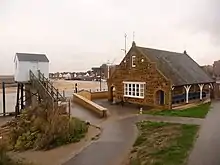 The First RNLI lifeboat station which is now used as the Harbour Masters Office and a Maritime Museum. It is a Grade II listed building.
The First RNLI lifeboat station which is now used as the Harbour Masters Office and a Maritime Museum. It is a Grade II listed building.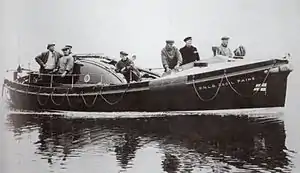 The Liverpool-class motor lifeboat RNLB Cecil Paine (ON 850) on station between 1945 and 1965.
The Liverpool-class motor lifeboat RNLB Cecil Paine (ON 850) on station between 1945 and 1965.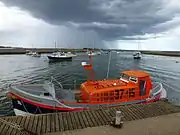 The Oakley-class motor lifeboat RNLB Ernest Tom Neathercoat (ON 982) on station between 1965 and 1990.
The Oakley-class motor lifeboat RNLB Ernest Tom Neathercoat (ON 982) on station between 1965 and 1990.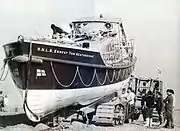 RNLB Ernest Tom Neathercoat (ON 982)
RNLB Ernest Tom Neathercoat (ON 982)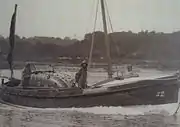 The Liverpool-class motor lifeboat 'RNLB Lucy Lavers (ON 832) on station in 1962 and between 1963 and 1964.
The Liverpool-class motor lifeboat 'RNLB Lucy Lavers (ON 832) on station in 1962 and between 1963 and 1964. The Surf-class motor lifeboat RNLB Royal Silver Jubilee (ON 780) was the first motor lifeboat at Wells and was on the station from 1936 until 1945
The Surf-class motor lifeboat RNLB Royal Silver Jubilee (ON 780) was the first motor lifeboat at Wells and was on the station from 1936 until 1945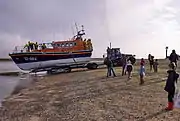 The Mersey-class lifeboat RNLB Doris M. Mann of Ampthill (ON 1161) arrived on station in 1990
The Mersey-class lifeboat RNLB Doris M. Mann of Ampthill (ON 1161) arrived on station in 1990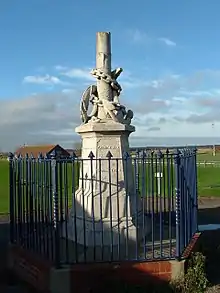 Memorial: Wells lifeboat disaster of 29 October 1880.
Memorial: Wells lifeboat disaster of 29 October 1880.
See also
References
- OS Explorer Map 251 – Norfolk Coast Central.Publisher: Ordnance Survey (2002). ISBN 0-319-21887-2.
- "D/IB1-class Production List". List of D-class inshore lifeboats, includes Jane Ann III D-661. Lifeboat World On-Line© 2014. Retrieved 20 March 2014.
- "Mersey-class 11.77m fast carriage boat". List of Mersey-class lifeboats, includes ON 1161. Lifeboat World On-Line© 2014. Retrieved 20 March 2014.
- For Those In Peril – The Lifeboat Service of the United Kingdom and the Republic of Ireland, Station by Station. Author: Leach, Nicholas. Publisher: Silver Link Publishing Ltd, First Issue 1999. Work:Part 1, East Coast of England, Berwick to Hastings, Page 44, Wells-next-the-Sea, Norfolk. ISBN 1 85794 129 2
- Title: The Beachmen. Author: Higgins, David. Publisher: Terence Dalton. ISBN 978 0861380473
- The Ship-Wrecks off NORTH NORFOLK. Author: Tikus, Ayer. Publisher:Ayer Tikus Publications, First Edition 2003. Work: The Beach Companies, Page 18, Description of the activities, reference to formation of Longshoreman’s company of Wells. ASIN B0032Z2NU0
- "Norfolk Heritage Explorer – Lifeboat House Wells-next-the-Sea". NHER No. 47433 – Description and details of the Lifeboat house. Norfolk Heritage Explorer © 2014 Norfolk Historic Environment Service. Retrieved 20 March 2014.
- Wells-next-the-Sea Lifeboats. Author: Leach, Nicholas & Russell, Paul. Publisher:Tempus publishing Ltd, Edition: first 2006. work: Appendix 2. Lifeboat details, page 115. ISBN 0752438751
- Historic England. "Lifeboat House, Wells-Next-the-Sea (1277330)". National Heritage List for England. Retrieved 7 October 2019.
- "Baltic Exchange Lifeboats". Details of the Baltic Exchange sponsorship of Wells Lifeboats. Baltic Exchange Information Services Ltd. Retrieved 20 March 2014.
- "Builders – Beeching Brothers of Great Yarmouth". The National Historic Ships Website. National Historic Ships UK. Retrieved 25 August 2013.
- "Surf-class 32 foot carriage boat". List of Surf-class lifeboats, includes ON780. Lifeboat World On-Line© 2014. Retrieved 20 March 2014.
- "Clayton Engineering – Talus MB-H Lifeboat Tractor". Description of the Talus MB-H tractor. Clayton Engineering Ltd. Retrieved 21 March 2014.
- Heroes All! – The story of the RNLI. Author: Beilby, Alec. Publisher:Patrick Stephens Ltd, First edition 1992. Work: Chapter 18, The Lifeboat Stations, Part 1, South from Spurn Head, Page 153, reference to the launching of RNLB Doris M Mann of Ampthill. ISBN 9781852604196
- "The Rescue Team Photograph". Short description and examples of the three photographs. Wells RNLI Lifeboat. Retrieved 21 March 2014.
- "Wells Harbour Commissioners and Staff". Photographs of the Wells Harbour Commissioners including Campbell Maccallum. Wells Harbour Commissioners. Retrieved 21 March 2014.
- Wells-next-the-Sea Lifeboats. Author: Leach, Nicholas & Russell, Paul. Publisher:Tempus publishing Ltd, Edition: first 2006. work: Chapter 1 – The first lifeboats at Wells 1869-1888. Schooner Emma, page 18. ISBN 0752438751
- Lifeboat Gallantry RNLI medals and how they were won. Edited by:Barry Cox. Published:Spink, London, 1998. Page 328 awarded on 10 October 1963.ISBN 0 907605 89 3
- Arun Lifeboats – An illustrated History of the RNLI Arun Lifeboats 1971 – 2009. Author: Leach, Nicholas. Publisher: Kelsey Publishing Group. Work: Part Two – The Arun class, boat by boat, page 50, City of Bradford IV. ISBN 9781907426216
- Never Turn Back – The RNLI Since The Second World War. Author: Kipling, Ray and Susannah. Publisher: Sutton Publishing Ltd, First edition – 2006. Work: Chapter 1, Lifeboat VC, pages 11 to 15, Waist deep in Water. ISBN 9780750943079
- "Norwave - (North Sea Ferries: 1965-1987)". Photograph images of the Norwave. Simplon Postcards. Retrieved 24 March 2014.
- Lifeboat Gallantry RNLI medals and how they were won. Edited by:Barry Cox. Published:Spink, London, 1998. Work: Page 368 COX David James – Coxswain Wells Lifeboat 1963.ISBN 0 907605 89 3
- Strong to Save. Author:Kipling, Ray and Susannah. Publisher:Patrick Stephens Ltd, 1998. Work: The North East – Designed for Danger, Page 52. ISBN 9781852604950